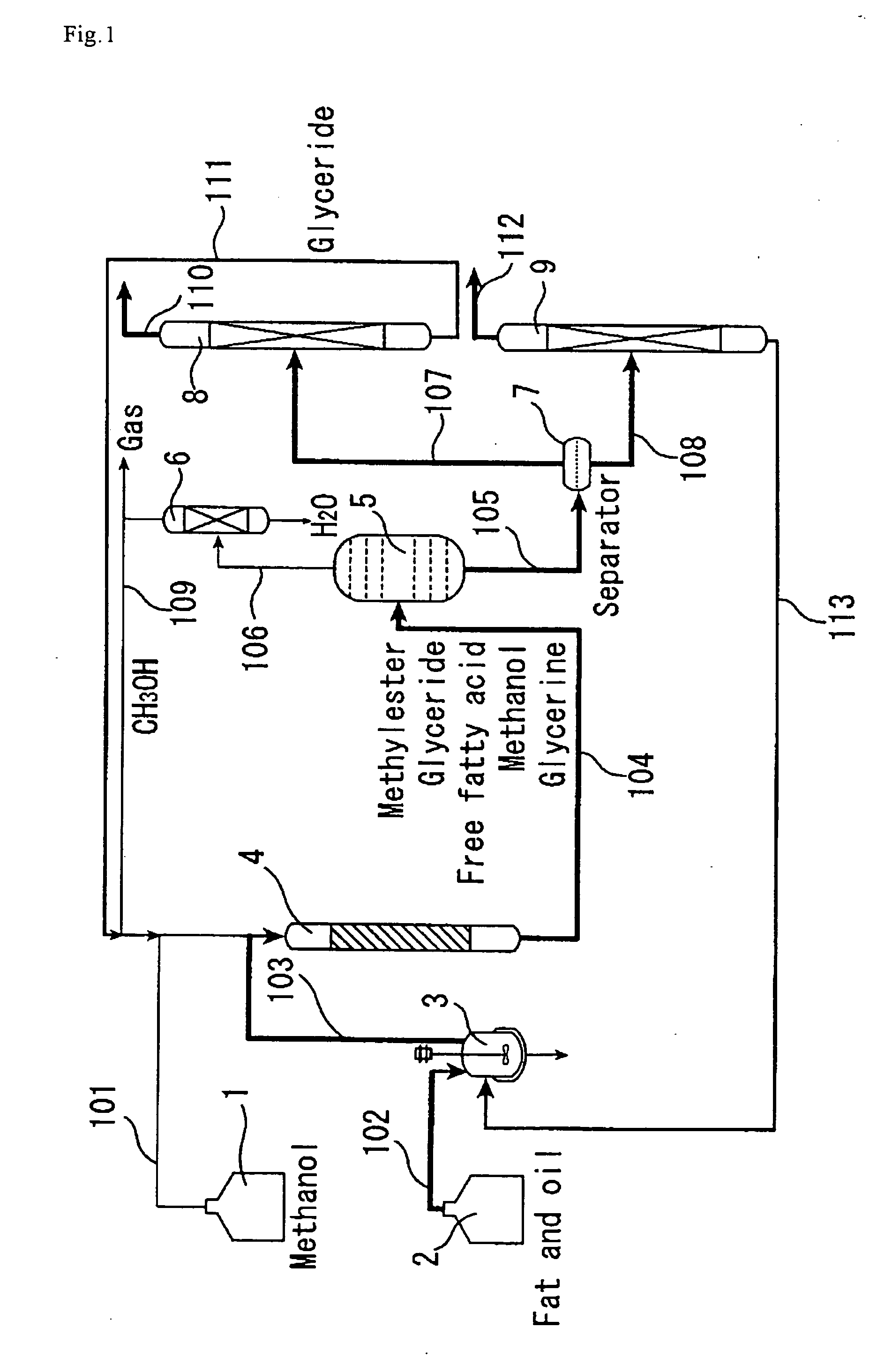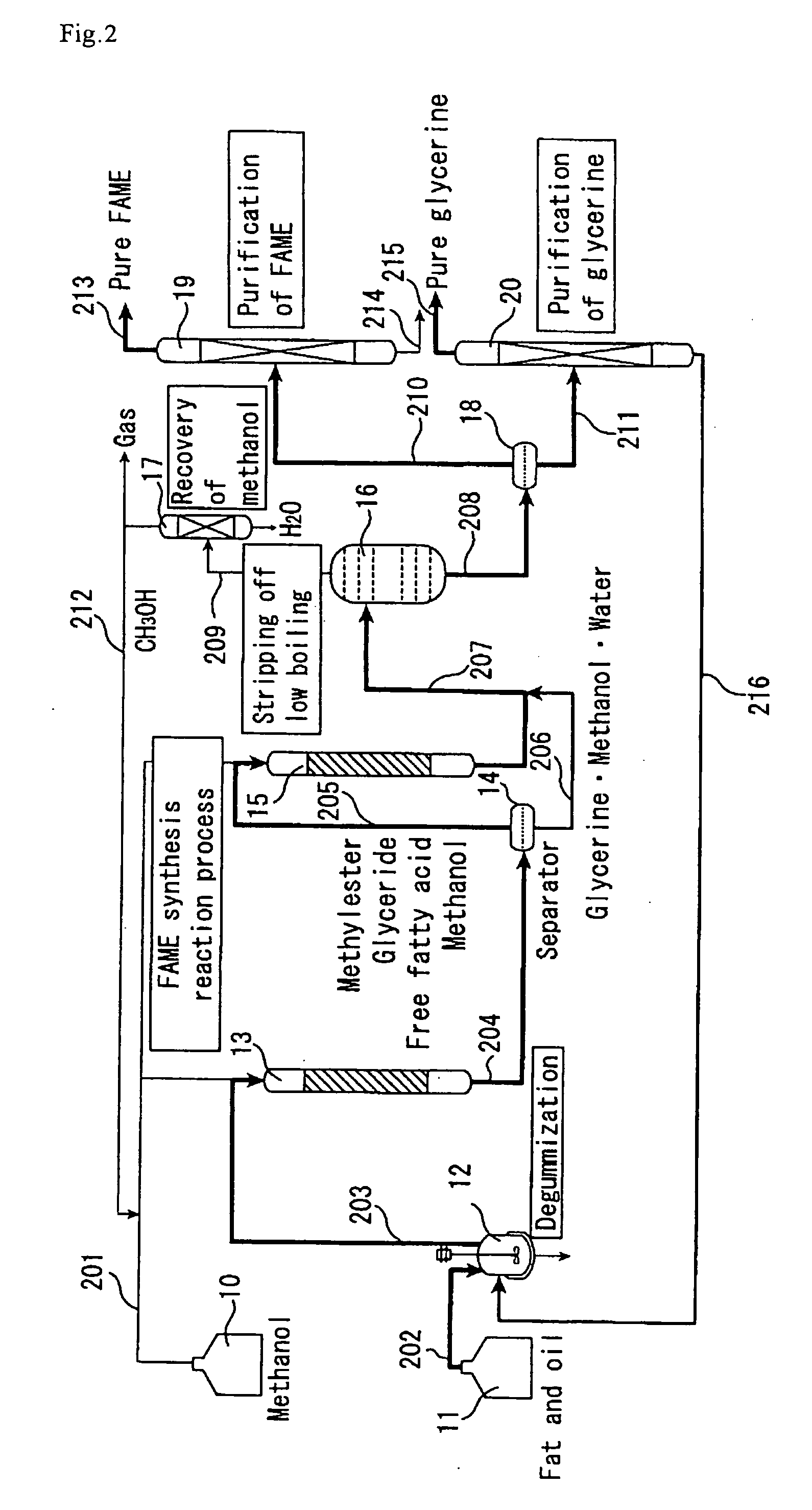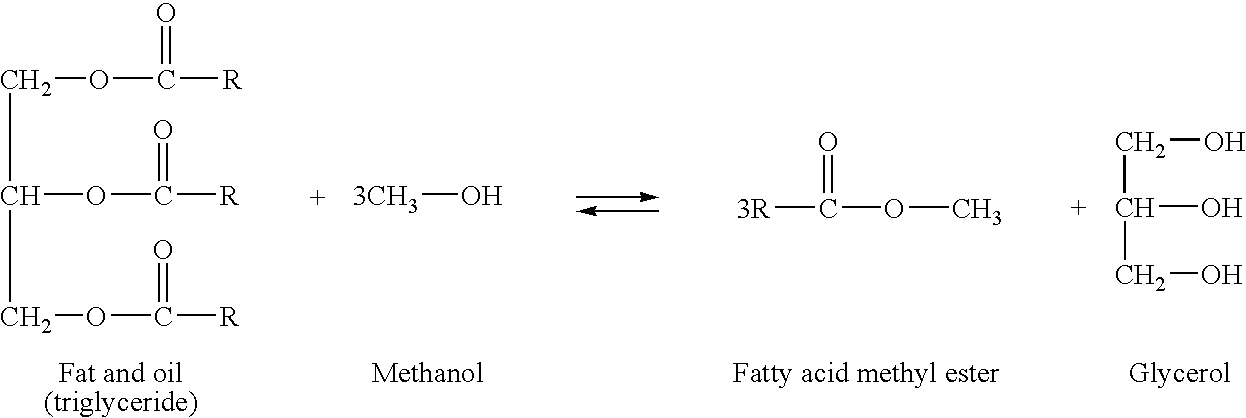Method of production of fatty acid alkyl esters and/or glycerine and fatty acid alkyl ester-containing composition
- Summary
- Abstract
- Description
- Claims
- Application Information
AI Technical Summary
Benefits of technology
Problems solved by technology
Method used
Image
Examples
preparation example 1
CATALYST PREPARATION EXAMPLE 1
[0121] Catalyst A: To a solution prepared by dissolving 25.74 g of ammonium metavanadate in 700 g of distilled water at 90° C. was added dropwise 169.66 g of a 20% aqueous solution of titanium(III) trichloride. After evaporation to dryness, the residue was preliminarily calcined at 350° C. under air atmosphere for 2 hours and then calcined at 750° C. for 5 hours to give a titanium / vanadium mixed oxide catalyst (catalyst A). X-ray diffraction analysis revealed that the catalyst A was a mixture mainly composed of a mixed oxide of the rutile-type TiVO4 structure and small amount of vanadium pentoxide.
[0122] Catalyst B: Potassium carbonate (13.9 g) was dissolved in distilled water (30 g). Anatase-type titanium oxide (16.0 g) and niobium oxide (Nb2O5) (26.6 g) were mixed up in a mortar, and the potassium carbonate solution was added to the mixture. The whole mixture was kneaded until it became homogeneous slurry. After 24 hours of drying at 120° C., calcina...
example 1
[0133] The catalyst A prepared in Catalyst Preparation Example 1 was compression molded, followed by crushing to attain grain sizes of 300 to 850 μm. The reaction apparatus shown in FIG. 1 was used, and a straight tubular reactor (4) made of SUS-316 stainless steel and having an inside diameter of 20 mm and a length of 450 mm was packed with the molded catalyst A (220 g). For enabling pressure control, the reactor outlet was equipped with a filter and a backpressure regulator via an air-cooled condenser. Palm oil and methanol were used as the reactant raw materials. Palm oil was deprived of proteins and phospholipids in advance by adding phosphoric acid to cause precipitation thereof, and the thus-degummed palm oil was used for the reaction.
[0134] Using high-pressure constant delivery precision pumps, the palm oil (205 g / h) and methanol (41 g / h) were mixed together in a line and continuously passed through the reactor downward from the top. The pressure within the tubular reactor w...
example 2
[0139] The catalyst A prepared in Catalyst Preparation Example 1 was compression molded and then crushed, followed by classification to collect grains with a grain diameter of 300 to 850 μm. The same reaction apparatus as shown in FIG. 2 was used except that it did not include the methanol recovery column (17). The reactants used were same palm oil and methanol as in Example 1. The first-stage reactor (13) (straight tube made of SUS-316 stainless steel, 26 mm in inside diameter and 500 mm in length) was packed with the molded catalyst (400 g). The reaction temperature was set at 150° C., and the pressure at 2.5 MPa.
[0140] Using high-pressure constant delivery precision pumps, the palm oil (205 g / h) and methanol (41 g / h) were mixed together in a line and continuously fed to the first-stage reactor (13) downward from the top. The supply of methanol relative to the palm oil was 1.8 times the theoretical amount to be fed. The yield of fatty acid methyl esters and glycerine in the first...
PUM
| Property | Measurement | Unit |
|---|---|---|
| Fraction | aaaaa | aaaaa |
| Percent by mass | aaaaa | aaaaa |
| Percent by mass | aaaaa | aaaaa |
Abstract
Description
Claims
Application Information
 Login to View More
Login to View More - R&D
- Intellectual Property
- Life Sciences
- Materials
- Tech Scout
- Unparalleled Data Quality
- Higher Quality Content
- 60% Fewer Hallucinations
Browse by: Latest US Patents, China's latest patents, Technical Efficacy Thesaurus, Application Domain, Technology Topic, Popular Technical Reports.
© 2025 PatSnap. All rights reserved.Legal|Privacy policy|Modern Slavery Act Transparency Statement|Sitemap|About US| Contact US: help@patsnap.com



